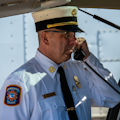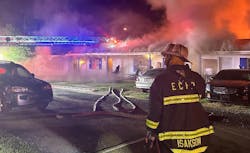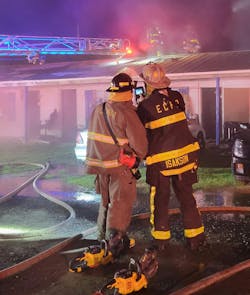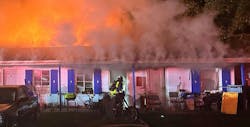Command & Control Success: Command Considerations
Communication is crucial in regard to fires. Communication to occupants that there’s a fire is more critical than ever based on today’s fire growth rate and less time to evacuate. The smoke that’s produced today is deadlier than ever and in a shorter period of time. In the past, firefighters and civilians could take in some brown smoke from Class A combustibles. They can’t take in that same amount today because of the hydrocarbon fuels that occupy almost every building, regardless of building classification. This emphasizes the importance of not only smoke detectors but monitored alarm systems that activate the 9-1-1 system, so as to not delay the response of firefighting forces. When a department is dispatched to a fire and the communication center announces that an incident initially was reported from an activated alarm, this hopefully signifies that there was less of a delay on notification to a potential fire. On the other hand, when a department is dispatched to a fire that initially came in via 9-1-1 callers, responding fireground commanders (FGCs) must consider that there might have been a delay in notification of the incident.
Years ago, shortly after midnight, a fire in a church that was located on a two-lane highway that had very little traffic was reported via a single 9-1-1 caller who observed a glow that was emanating from the rear and heavy smoke surrounding it.
While responding, and knowing that the communications center was reporting that a lone 9-1-1 caller was describing smoke and flames, I thought about the delay in notification and that the fire already might be self-venting. How a fire is communicated is a big part of the pre-arrival size-up to determine the strategy and tactics (and their order) that potentially are necessary for command success.
Time of day, day of the week and week of the year also are big factors regarding potential challenges. In addition to potentially determining notification time, they also determine occupancy numbers of a given building and/or travel time. This should be considered in regard to fire growth before the arrival of firefighting forces.
Another example: a serious fire in a vacant motel (Type 5). The fire occurred on the last Saturday before public schools and colleges returned for the fall. It was 7 p.m.,
one hour before sunset. The day of the week, week of the year and the time of day determined available water supply: Visitors getting in one last weekend at the beach before school started—taking showers/rinsing off the salt water—caused all of the above-ground water tanks to be empty.
When Tower 13 set up for master stream operations, there only was a very weak fire stream because of very low water pressure. The first hydrant (located in front of the building) provided less than 500 gpm. To make matters worse, wind speed was 20 mph or faster. These two factors determined an immediate need for the water department to boost pressure and for a request for tenders to respond.
With a large, fast-spreading fire in a vacant, wood-frame motel and significant exposure issues, a strategy that would work with a limited water supply in regard to the required fire flow needs was critical. In addition, a large number of people who occupied exposures and of spectators required consideration on deployment of resources and communicating the strategy, so all of the firefighting resources were on the same page, working toward stabilizing the incident. As the FGC, I had to communicate in a way that provided command presence and showed confidence.
The sooner that the FGC determines the resources and logistics that are necessary for a given fire, the quicker that the FGC can request the resources and logistics from the communication center.
Radio & face-to-face
One of the most important tools that an FGC has is the mobile and/or portable radio to request resources, to communicate what’s required of firefighting resources and to deploy them to support the overall strategy of extinguishing the fire. That said, the FGC must have a plan and immediately sound off the plan, utilizing fire companies to complete specific tactics that support other tactics that are carried out by other fire companies. These tactics might be done systematically and/or simultaneously.
When appropriate, the FGC should be as visible as possible to as many firefighting and other resources as possible. Communication then becomes audible, as command assignments are given over the radio. Note: Even when command assignments can be given face to face, sometimes, they should be communicated over the radio, so other firefighters and fire companies are aware that other tactics that support their tactical assignments are being assigned.
Of course, the FGC is only part of the two-way communication. There must be a receiver who hears and acknowledges the message, either through repeating it back or through the action of carrying out the command. This is another reason why it helps that the FGC be in a position that provides the best view of the fireground. At a recent multi-alarm fire in an apartment building, I positioned myself in such a way. A few times, I observed that my message wasn’t received by the firefighters, engineers and/or officers: Their actions didn’t reflect my instruction. This immediately informed me to give the command assignment again and then request confirmation that the command was received.
Multiple radios
When operating outside of the command vehicle and/or remote from it, it’s critical for the FGC to carry a minimum of two portable radios. This allows the FGC to have one radio on the command channel and another on the tactical channel, the latter to command firefighters/fire companies. I prefer this radio to be in a radio sling that’s under my coat. This allows me to not delay if relieved of command and assigned as an interior or operations chief.
The second radio is in my coat pocket, or I hold it, depending on my current actions. I utilize this radio to request more resources, to communicate with responding resources and, when possible, to communicate anything that doesn’t relate tactically but supports the strategy of fire extinguishment. This minimizes the radio traffic that operating firefighters and fire companies must process. When firefighters operate in the immediately dangerous to life and health (IDLH) environment/interior of a building fire, it’s vital to minimize unnecessary radio traffic that they hear. This allows them to focus on the task at hand and also provides a higher probability that they keep their portable radio turned up and receive critical messages.
The battlefield
Once you are dispatched, you start to consider information that’s reported to construct your playbook for the incident. Time is limited. Time-compressed decision-making under various challenges, such as sleep deprivation, is part of the job.
A key consideration is the building that’s reported to be on fire, its type of construction, and intended occupancy versus potential occupancy at the time of fire. Floor plan design and fixed fire protection systems are among a variety of considerations, particularly anytime that a building was converted to a different occupancy/use. When a building was converted, more times than not, it was converted to a larger occupancy, which increases the odds of injury or death for trapped occupants. With this, the FGC must consider what resources are needed compared with that which would be required based on an original dispatch that pertains to old information.
In July 2024, my department and I responded in the middle of the night to a multi-alarm fire at a former motel that was converted to permanent living/apartments with rear additions. Further, in the rear of the building, people were living in a motor home that was converted to permanent living, and there were campers/squatters. In total, the density of people was way beyond what it was in previous years when people stayed temporarily.
The building was 70 years old. It was constructed of cinderblock. It had tongue & groove ceilings and a flat, gravel roof. A medium-pitch metal rain roof was added onto the gravel roof.
The units in the building still were the size of standard motel rooms, but they contained all of the things that people who live permanently in an apartment have. So, the fire load and egress issues increased within the same square footage. These factors also caused challenges/delays for both the fire attack team and the search team. Numerous separate units required command to consider the number of fire attack teams, search teams, vent teams and rapid intervention teams (RITs).
Breaching a wall wasn’t realistic. Breaching a cinderblock or concrete wall is totally different than breaching a wood-frame wall that’s covered with gypsum wallboard or plasterboard. Also, attacking fire that started in or spread to an attic is more challenging based on the tongue & groove compared with a newer gypsum wallboard or plasterboard ceiling. The metal roof added another compartment that might require fire attack. So, pulling ceilings, cutting the roof and getting water into the additional attic space presented a more challenging, more time-consuming operation.
It’s important to be ready and consciously realize when there’s a need to deviate from traditional tactics—for example, utilizing a cellar nozzle or attic nozzle—to extinguish fire in void spaces with limited resources in a shorter period of time.
Also, take into consideration that a metal roof of this type probably won’t self-vent and burn away. It potentially will cause more of a collapse hazard than a lightweight wood decking roof does. This causes a greater risk of entrapment to firefighters who operate under it. This increases the need for a well-trained RIT. The FGC also might consider two RITs, to stage in front of and in the rear of the building.
The tools that are carried must be considered. If firefighters become trapped, how long have they been operating on air, how much air do they have left and how long will it take to reach them with an additional supply?
Lessons reinforced
The incident at the converted motel had active fire in numerous units, with heavy smoke pushing from the entire building. A large amount of fire and glow showed from the rear of the building on arrival. Because the building lacked a monitored alarm system and the incident occurred in the middle of the night, the fire had a longer burn time before the communications office was notified of the fire.
I arrived simultaneously with the first engine company. We both observed a large number of people exiting numerous units through a significant amount of smoke. This presented me with additional information to consider. I immediately requested a second alarm for more resources (including numerous search teams to search simultaneously) because of the large number of people who might need to be rescued, removed and, possibly, resuscitated. This resource is above and beyond the need for numerous attack lines in different units.
Also taken into consideration: This was a contiguous structure that was rather wide, and access to the rear was more challenging than that of an average private dwelling. A large number of the units didn’t have rear doors, which hampered access to the rear even more.
Once I started to assign fire companies to fire attack (supported by forcible entry personnel where needed, search team members, ventilation crews, RIT personnel, water supply and the command team), the first-alarm and second-alarm fire companies were assigned, or all-hands operating, as some departments call it. This doesn’t cover if one or more unconscious civilians and others who need medical care must be removed. Furthermore, this doesn’t account for some type of significant event (e.g., an explosion, collapse or trapped firefighter, which would require more than the original assigned RIT) nor that it was very hot and humid that night, which caused more rapid fatigue of operating firefighters.
Based on experiences that I described in a previous Command & Control Success column, “Depth on the Bench,” I rapidly requested a third alarm. I also took into consideration the time, distance and travel of the third-alarm companies, based on us being a county department that’s spread over 664 square miles.
We must operate like the sports teams that have backup players and relief players in the event that a game goes into overtime. We also must operate like the marching band and play from one sheet of music, stay in tune and follow the band director, who’s reading the music.
About the Author

Curt Isakson
Curt “Ike” Isakson is a 30-plus-year veteran of the fire service. He worked for Escambia County, FL, Fire Rescue for 25 years. Isakson previously worked nine years for the Pensacola, FL, Fire Department, where he was assigned as a company officer on Heavy Rescue 31. His fire service experience started at a young age as a junior firefighter with the Midway, FL, Fire District; he rose through the ranks to captain. Isakson's identification of the need for a series of special-interest fire conferences spawned the development of County Fire Tactics, which covers officer development, command officers, water on fire, high-rise operations, and leadership and tactics.


